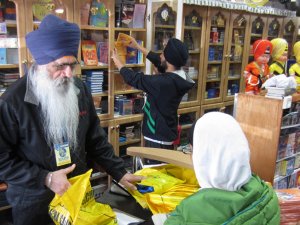The California based Chardi Kalaa Foundation, working jointly with Sikh Gurdwara San Jose and SikhNet, is now in the sixth year of its annual laboratory on mining the teachings of the Guru Granth Sahib; an experiment launched in 2012.
So, what else is new, you might ask. Isn’t all life teaching and learning, from birth to its inevitable end? We also know that religions usually demand unquestioned obedience to a path rather than asking us to reason our way along the journey.
Faith and reason are each necessary, but neither one is sufficient alone. The dual lenses of both reason and faith are essential to engagement with Sikhi. The two together create a totality that’s greater than the sum of the parts.
The result is then best experienced as grace, like manna from heaven, not like an earned skill —mastered after copious blood, sweat and tears — nor does it come with a sense of entitlement.
The theme of the conference remains essentially unchanged from five years ago: Applying the universal message of Guru Granth Sahib across centuries, cultures, religions and continents in today’s world.
Over the last couple of years, we made some changes aimed at engaging more strongly with younger Sikhs. The 2016 Conference program started with beautiful kirtan renditions by two award winning jathaas of young children (watch video here.)
This was followed by an interactive panel discussion with six very articulate young women on The role of women in building a future for the Sikhs. (watch video here.)
Another feature introduced at this year’s conference was two sessions of short speeches by Sikh children on “The context of Sri Guru Granth Sahib” and “Is it OK to eat meat according to Gurbani.” These speeches were originally given at the worldwide Hemkunt speech competition.
The rest of the day went to seven participants who had been invited to present papers on a theme from Guru Granth and its eternal message. Free flowing discussion was the hallmark. To ensure this, the exchange proceedings occurred neither within the Gurdwara Darbar Hall, nor in any room with the Guru Granth ensconced, but in the adjoining Khalsa School building. Participants thus could speak freely without worrying that their demeanor or words might contravene protocol and tradition, even if inadvertently.
Most participants were either born and/or raised outside Punjab and India; they also exhibited a challengingly large age-span – from the energetically young, barely out of their teens and just stepping into the professional world, to others who are certifiably entering the winter of their lives. They are best pigeon-holed mostly as products of a predominantly Western worldview, exhibiting varying intimacy with Sikh and Punjabi culture.
Keep in mind that some differing perspectives come together in this initiative; at times, the fit may be less than seamless. The Chardi Kalaa Foundation and the Sikh Gurdwara, San Jose initiated the project, and now SikhNet, the preeminent Internet portal on Sikhi, is also a major contributor. This is how lasting institutions are built, and heaven knows we need them.
Some participants come from academia, where they hold appointments on and about Sikhi. Others are best labeled educated Lay-Sikhs. Some have serious interest in Sikhi; others may be just a shade closer to fellow travelers. But we appreciate their dedication and presence.
This sorely needed generational and inter-gender interaction is usually evident neither in our community nor in its institutions.
Some weeks later, after some necessary cajoling and reminding by two of us (Inder Mohan Singh & GP Singh) participants submit final versions of their papers. Each year they have been collated as special issues — of The Sikh Review (Kolkata, India) for the first two symposia, and of Nishaan (Delhi, India) for the next two. The papers are also published online on the Chardi Kalaa Foundation web site along with videos of all the conference sessions. English is the language of choice, but some mixing with Punjabi and the rich language of Gurbani inevitably occurs.
How do we go about selecting and inviting participants? Not all that easily. The goal is an eclectic mix of participants representing the community. Each year we try to attract some new talent – from mainstream Sikhi and even from Sikh communities of non-Indian origin. These include some who were born and/or raised in North America; from urban settings and rural enclaves; one or two come directly from India; some who discovered Sikhi later in life; even those who represent different streams of Sikhi in their personal and community life.
Sikhi is now a world-wide faith of about 25 million adherents and is comfortably ranked as the fifth or sixth largest religion. In numbers, it follows Christianity, Hinduism, Islam and Buddhism; at this time its place vis-a-vis Judaism remains an open question.
Our participants reflect this complex global presence of Sikhi’s rich reality. The learning and teaching flow directly from this fact.
We encourage lively and open conversation, as should be norm in any vibrant community with a commonality of practices. Interpretations of the same fundamentals will differ, even strongly, among equally dedicated minds.
We accept and foster the belief that unanimity of opinion and homogeneity of thought are not the hallmarks of Sikhi or any living community. How to differ and disagree without becoming disagreeable is the goal. These basics are essential to progress. Sikhi offers us a rich tapestry to behold.
Such goals demand careful watchfulness and self-discipline; occasionally we fall short on one or both counts. These are human frailties and should shock no one.
We celebrate our connection to the San Jose Gurdwara; it continues to create sensitivity and mold our social behavior. Each passing year more people from the gurdwara drop in on our symposia. Some of them are surely new to the idea of free discussion and debate on and about interpretations of Gurbani.
Our challenge: how to shape our rhetoric such that it honors the core idea of freedom of speech while preserving intact the reverence for Gurbani — the appropriate demeanor and ambiance.
This becomes a challenge when the blood is a-boil. From us, this demands a paradigm shift, a state not so easily attained. This skill needs constant honing, regardless of where one learned life’s basic lessons – in academia or on the streets.
It is self-evident that we need spirited, even raucous debate on the most dearly held beliefs and practices that lie at the core of our lives. This is how we implant them within us. Then we own them and they become defining dicta for which good people will live and die. Thus, they will transform us.
The presentations reflect wide ranging intellectual forays in and about Sikhi. Assertiveness is desirable, aggression is not. Assertive debates show where the questioning mind is at a given time. This means that there are no bad questions; only inadequate answers. Also, no one may have an absolute answer to a question. Such exchanges, too, are welcome; answers, partial or complete, may surface then, or later with time. We will learn to disagree and yet continue. In this process is a lot of learning. Teaching and learning are inseparable twins; there is a whole lot of learning within teaching for both teachers and students.
To summarize our approach: As one of us (IJ Singh) who has taught at a university for umpteen years likes to warn his students, “I am not here to pour information into you as if you are empty, perhaps bottomless, buckets, but to make it possible for you to learn what your talents and inclinations allow.”
A most critical matter in learning and teaching is not to always offer stone-etched answers to a query but have the willingness to step into uncharted territory; and to hold our biases tentatively, not with certainty. And explore our beliefs in the marketplace of ideas.
A quick scan of the contents will inform readers of the variety of topics that engaged us at this Conference. We assure you that the last word on any single topic has not yet been said. These matters will continue to engage us for many a lifetime and each generation, we fondly hope, will continue to revisit these and related matters anew. As long as life lasts, it will continue to refill our plate with such themes with many variations on them, alongside newer mysteries to decode and decipher. And we will lean on our growing understanding of Gurbani for this process.
The larger purpose of these sessions remains unchanged since their beginning in 2012. Five hundred years ago, Sikhi’s message was transformational for the people of Northwestern India and neighboring areas. Today the Sikh message remains unique, universal, timeless and practical. It is designed for the thinking person and most powerfully expressed through the words of Sri Guru Granth Sahib.
Sikhi spoke eloquently to people in India then, and it speaks just as powerfully to us today, over 500 years later and 10,000 miles away. Obviously then, we need to stay connected to the repository of our spiritual heritage, Guru Granth. Mining it to give purpose, direction and meaning to our lives demands that our exploration of the Guru Granth Sahib never ceases. This is and remains the unchanging over-arching theme of these annual symposia.
Our larger purpose remains to be the bridge that spans the inter-cultural and inter-generational divides that often fragment our community; in other words, to construct linkages that connect home and work with our community centers (gurdwaras.)
This seems to be the only way that our subdivisions can be subsumed into a larger reality. All people — no matter their age, color, culture, gender, language or religion — need such connections for survival and growth. This is how dynamic communities grow and thrive.
Remember that this was only the fifth year of our activities; there are many more years to go. Grateful thanks to the participants, those who flawlessly managed the occasion as well as Pushpindar Singh, Monica Arora and the staff of Nishaan, the quarterly journal. Guru Granth Sahib exhorts us to come together and collectively work through our differences (Hoi Ikatr milo mere bhai; Dubidha door karo liv layee, p. 1185.)
The debates and discussions remain passionate, as they always should. They define a process and a place to preserve and nurture what makes us what we are. That is what we need to treasure.
The journey is the destination.
On August 19th, the 6th Annual Siri Guru Granth Sahib Conference took place at the Sikh Gurdwara San Jose in San Jose, California. Thought-provoking presentations were given by a range of authors and scholars on the theme of applying the timeless, universal message of SGGS - across centuries, cultures, religions and continents - in today's world.
If you missed out on this year's event you can still experience the wonderful talks and presentations through video. Follow the links below to experience the wisdom and insight shared by the various speakers!
3. Living in Alignment with Hukam
4. ਗਲੋਬਲ ਸਰੋਕਾਰਾਂ ਵਾਲਾ ਧਰਮ ਗ੍ਰੰਥ : ਸ੍ਰੀ ਗੁਰੂ ਗ੍ਰੰਥ ਸਾਹਿਬ
5. Interconnected Ethics: Living as Warrior-Saints for the Freedom and Equality of All
6. Siri Guru Granth Sahib “A model of Human Harmony and Global Peace”
9. Apply the Guru’s Teachings to Progress from Human to Divine Love






